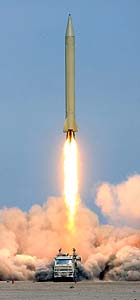· Warning as Swiss destroy documents to prevent leak
· Copies may remain with data smuggling network
 Iran tests a Shahab-3 long-range missile in 2006. Some fear it could be adapted to carry a nuclear warhead using information possessed by Abdul Qadeer Khan network, which had contact with Iran. Photograph: Ruhollah Vahdati/AP
Iran tests a Shahab-3 long-range missile in 2006. Some fear it could be adapted to carry a nuclear warhead using information possessed by Abdul Qadeer Khan network, which had contact with Iran. Photograph: Ruhollah Vahdati/AP
Nuclear bomb blueprints and manuals on how to manufacture weapons-grade uranium for warheads are feared to be circulating on the international black market, according to investigators tracking the world's most infamous nuclear smuggling racket.
Alarm about the sale of nuclear know-how follows the disclosure that the Swiss government, allegedly acting under US pressure, secretly destroyed tens of thousands of documents from a massive nuclear smuggling investigation.
The information was seized from the home and computers of Urs Tinner, a 43-year-old Swiss engineer who has been in custody for almost four years as a key suspect in the nuclear smuggling ring run by Abdul Qadeer Khan, the Pakistani metallurgist who in 2004 admitted leaking nuclear secrets and is under house arrest in Islamabad.
The Khan network trafficked nuclear materials, equipment and knowhow to at least three countries: Iran, Libya, and North Korea.
President Pascal Couchepin stunned his Swiss compatriots last week by announcing that the Tinner files, believed to number around 30,000 documents, had been shredded. The extraordinary move, prompting demands for a parliamentary inquiry, was warranted to prevent the documents "getting into the hands of a terrorist organisation or an unauthorised state", according to Couchepin.
However, there are widespread fears this has already happened or still could. "We know that copies were made," said Mark Fitzpatrick, an expert on the illicit networks at the British-based International Institute of Strategic Studies (IISS). "Both US intelligence and the IAEA [International Atomic Energy Agency, the UN's nuclear watchdog] had been pursuing this with great urgency and diligence. But what happened to the other copies that [Tinner] made? It is worrisome that there are other plans floating around somewhere out there."
Testimony at the 2006 trial of another Khan network suspect in Germany alleged that Tinner told investigators he had nuclear bomb designs at his office in Switzerland. The blueprints were in digital form and are believed to have been copied on to the network's computers in Dubai, the hub for the Khan operation.
"It's amazing these people had so much information, incredibly sensitive stuff on nuclear weaponisation and gas centrifuges," said David Albright, a Washington-based former UN weapons inspector. "I'm sure the US got a copy. But who else got the documents? Can you believe these two, the brothers [Marco Tinner is also in custody] were the only ones who got the stuff?"
In his first interview since 2004 with the western media this week, Khan told the Guardian that the Swiss case proved that anyone seeking a nuclear bomb could easily obtain the wherewithal in the west.
He pledged he would never assist western or UN authorities and asserted that his "confession" of February 2004 was coerced by the Pakistani regime.
While the Swiss government maintains the treasure trove of nuclear intelligence was destroyed for reasons of national security, the Americans may have been involved because Tinner is believed to have also been working for the CIA. Albright said Tinner was recruited by the American agency from 1999-2000.
"The Swiss were doing other people's dirty work," said an international official familiar with the investigation into the Khan network. "The allegation is that Urs was on the CIA payroll for a very large sum of money."
Olli Heinonen, deputy director general at the IAEA, has led the investigation into the Khan network for years. Last year his office sought and gained access to the Tinner files and some of his officials were also summoned to witness their destruction.
The Americans were also present, according to the international official. "The Americans were involved in the destruction. They were calling the shots," he said. The IAEA refused to comment publicly on the case. A former senior IAEA official said: "I am quite astonished. It's very unusual to see people destroying documents like this. They should be put somewhere very safe.
"The real question is how many copies of these documents existed. If copies were made, where did they go. That's the main issue."
The documents unearthed in the Tinner investigation were so "explosive", said the government in Bern, that it was obliged to destroy them as a non-nuclear state that is a signatory to the nuclear non-proliferation treaty.
President Couchepin said: "There were detailed construction plans for nuclear weapons, for gas ultracentrifuges to enrich weapons-grade uranium as well as for guided missile delivery systems."
Had the evidence been presented in court, compromising and embarrassing information about the CIA's activities with the Khan network could have surfaced, say experts and officials.
However, destroying the evidence will jeopardise a successful prosecution of Tinner, whose brother, Marco, and father Friedrich have allegedly long been associated with the Khan network.
Friedrich Tinner's relationship with Khan goes back to the 1980s. He was also investigated for aiding Saddam Hussein's alleged nuclear bomb projects.
"The Swiss family headed by Friedrich Tinner was key to the Khan network for many years," wrote Fitzpatrick of the IISS in a study last year of the Khan network.
http://www.guardian.co.uk/world/2008/may/31/nuclear.internationalcrime

![[Image6.jpg]](https://blogger.googleusercontent.com/img/b/R29vZ2xl/AVvXsEgNaIXg0_48iqICxzb6odLToabJmiXgIjhmXaaQyem2ZqzqBXttSLZ5ZLzpqG48utbI-EPPDZOwHW19xkVk6_qj-4gGaiLcqw1Lumv61U_Dp6ry0lnUKPQjm4QQaBs91esrSLKl7FKZEg/s1600/Image6.jpg)




![[Zionazis-1.jpg]](https://blogger.googleusercontent.com/img/b/R29vZ2xl/AVvXsEikwu0oZAslARhcp5cHmtn_ED-tlInbWtl392lehVem2UebCE8-gQUb_PM9b3QAHAeIAZqOe9OdInZLq5FQj9DJQ1WO-Fwk2rFEj21TTXPcrfgRXuKUBajDSGzzQbZYupW7oQgq9YhhZg/s1600/Zionazis-1.jpg)


